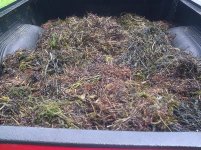There seems to be a lot of interest in the collection of natural local materials for use in the home garden. This can be a touchy subject so I will create this thread for people to learn and ask for the proper methods of wild harvesting particular plants. This way the natural world and you both benefit from the interactions between the two of you.
there are a few simple rules when collecting wild materials.
1 - do not overharvest
2 - know the plant/material your dealing with, not the plant/material you "think" you know
3 - proper harvesting methods can increase production and quality, improper methods reduce production and quality.
4 - respect the natural world, without it you wouldn't be collecting shit.
if you want to know how to harvest a plant, read through or search the thread first before asking. since the thread is new, ask.
i will update some good posts later today when i gather some thoughts.
a quick tip for those new to foraging for wild stuff. if you follow this you will be pretty safe. i got this from Green Deane of eattheweeds.
when wildharvesting plants you have to I.T.E.M.ize it first.
I - identification - is this the plant you think it is, does it have multiple traits related to the plant you seek, if you dont know this, do not proceed.
T- time of year - is it doing what its supposed to be doing when its supposed to be doing it. if its flowering in january when its supposed to flower in the fall, chances are you have the wrong plant.
E - environment - is it growing in a good healthy spot. free of pesticides, chemicals, herbicides, motor oil, car exhaust, etc....
M - method of preparation - know what to do with the materials you have collected, so that they do not go to waste.
ill add this to the first post to help.
there are a few simple rules when collecting wild materials.
1 - do not overharvest
2 - know the plant/material your dealing with, not the plant/material you "think" you know
3 - proper harvesting methods can increase production and quality, improper methods reduce production and quality.
4 - respect the natural world, without it you wouldn't be collecting shit.
if you want to know how to harvest a plant, read through or search the thread first before asking. since the thread is new, ask.
i will update some good posts later today when i gather some thoughts.
a quick tip for those new to foraging for wild stuff. if you follow this you will be pretty safe. i got this from Green Deane of eattheweeds.
when wildharvesting plants you have to I.T.E.M.ize it first.
I - identification - is this the plant you think it is, does it have multiple traits related to the plant you seek, if you dont know this, do not proceed.
T- time of year - is it doing what its supposed to be doing when its supposed to be doing it. if its flowering in january when its supposed to flower in the fall, chances are you have the wrong plant.
E - environment - is it growing in a good healthy spot. free of pesticides, chemicals, herbicides, motor oil, car exhaust, etc....
M - method of preparation - know what to do with the materials you have collected, so that they do not go to waste.
ill add this to the first post to help.
Last edited:






